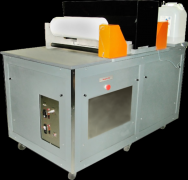
Multipoint synchronous pore structure analyzer
In the production process of many rolls, the multi-point synchronous pore structure analyzer can determine whether the product is suitable for various applications and control production parameters in completed and unfinished woven sheet products and non-woven materials, optimize the quality required for product production, the pore structure characteristics of the product, and the necessary width and length. The multi-point synchronous pore structure analyzer is designed for such applications.
The thin plate being tested in the instrument passes through two flat parallel plates. The top plate has straight cylindrical holes to accommodate a reverse cup-shaped sample chamber and a sample with a diameter of approximately two inches. The bottom plate also has through holes aligned with the holes on the top plate. There are five sample chambers with a width of 20 inches on the product. When the sample chamber descends towards the hole on the top plate and comes into contact with the thin plate, there is a gasket at the bottom edge of the sample chamber to ensure pressure is sealed with the thin plate. The top of the sample chamber is connected to a pressure sensor to ensure that the pressure is just above the sample. The sample room is also connected to a gas transmission pipeline to provide compressed gas for the sample room, which is used to discharge a specified amount of moist liquid. The output port of the small valve on the sample room sample can enter the sample room, and the computer-controlled valve can discharge the moist gas at the required time.
Technical principles:
The capillary flow pore gauge is used for conducting pore structure characteristic tests. Under this technique, the flow rate of inert gas passing through the sample is measured based on pressure difference under both dry and wet conditions (using appropriate moist gas). Differential pressure generates hole diameter.
D is the diameter of the hole, γ It is the surface tension of a moist liquid, θ It is the contact angle of the liquid, and p is the pressure difference.
The dry and wet gas flow rates are used to calculate other pore structure characteristics such as pore distribution and average flow pore diameter. The dry flow rate is used to calculate gas permeability after Darcy's law, and gas permeability is generated based on the liquid flow rate measured by pressure difference.
Product features:
The unique advantages of using this instrument:
1. Record the performance when rolling the sheet, which is a permanent record of the pore structure characteristics of the entire roll.
2. If the performance is not within the acceptable limits along the width or length, the unacceptable parts can be discarded, so as not to cause customer dissatisfaction and additional costs.
3. Early detection of major errors can lead to modifications to production control parameters, resulting in more acceptable products.
4. Minimize losses, reduce costs, and optimize products.
Prev: Haze meter
Next: Multi-step compressor